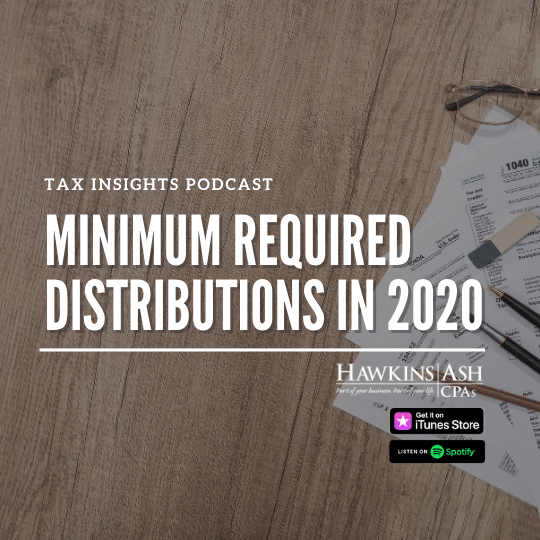We talked back in January 2020 about required minimum required distributions and how they are calculated. And that seems like a lifetime ago, rather than just six months … but I want to circle back—not necessarily how to calculate it, but just some changes that have happened.
So what age can you do this; has that changed?
It has. So forever the minimum required distribution age has been 70 ½, but now that has moved up to age 72. Now, this doesn’t affect people that were turning 70 ½ in 2019; it only affects those turning 70 ½ here in 2020. Those individuals don’t have to start taking any kind of required minimum required distributions from their IRAs until age 72—so a couple years from now.
Now, I also heard that people don’t have to take a distribution this year.
That’s right. Because of the COVID-19, because of the way the stock market decreased, the 2020 requirements have been lifted. And this makes sense, because you really don’t want to take money out when the stock market is low (and earlier in the year it really went down quite a bit). You want to make sure that that amount stays in there so that it can grow and you can take it out later. You know, the old adage that says, “Buy low, sell high.”
Right—so you don’t lose money until you take it out. Say I took it out, and now stocks are on sale; can I put it back?
You can. Because they actually said that—for 2020 only—as long as you put back any distributions that you’ve taken so far by Aug. 31, 2020, it will be treated like you never took it out.
There has to be a catch here …
There’s a little bit of a catch, because of course most people have withholding taken off of their IRA payments, and if you had federal or state withholding taken off, that amount might not be able to be put back in.
Anything else on changes with the distribution rules?
I think a lot of that covers it. But one thing that I kind of want to go back to is those QCDs, or qualified charitable distributions. As a reminder, this is a way that people over 70 ½ can have their IRA funds transferred directly to a charity and take a deduction, even if they don’t itemize. And with the itemized deduction (you know, the standard deduction) being a fairly high threshold now, a lot of people are taking the standard deduction, but this is a way to take a deduction without having to itemize.
So, even though the age for distributions changed from 70 ½ to 72 for people who have to take those minimum required distributions, the age is still 70 ½ for people that want to transfer money right from their IRAs directly to a charity and essentially get a deduction for it. If you want more information on that, though, I would suggest going to our website, because we have a lot of good information on that. And of course, everybody’s circumstances are different; nobody’s circumstances are the same. Be sure to contact us with any questions.





